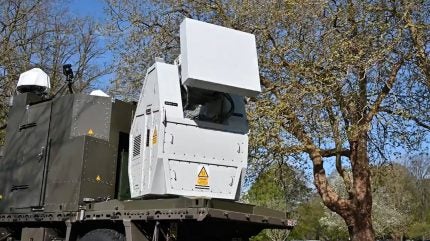
The UK has developed a prototype radio frequency anti drone system that could have applications across all three domains, as the military need to produce effective defence against uncrewed platforms continues to be shown on a daily basis in the Ukraine-Russia war.
On 16 May 2024, the UK’s Defence Equipment & Support (DE&S), an arm of the Ministry of Defence, showcased the development of the Radio Frequency Directed Energy Weapon (RFDEW) system, which can detect, track, and engage a range of threats across land, sea, and air.
The system has been developed by Team Hersa, a joint DE&S and the Defence Science and Technology Laboratory (Dstl).
According to DE&S the system will be able to effect targets up to 1km away, with further development in extending the range ongoing. In order to disrupt drone targets, the system beams radio waves to jam or damage the critical electronic components of enemy vehicles, either causing a platform loss or immobilisation.
UK Minister for Defence Procurement James Cartlidge said that the war in Ukraine “had shown the importance of deploying uncrewed systems” but that it was equally important that the UK be able to effectively defend against such threats.
At only 10p (approximately 13 US cents) per shot fired, DE&S stated that the RFDEW beam is a cost-effective alternative to traditional missile-based, air defence systems, capable of downing dangerous drone swarms. The high level of automation also means the system itself can be operated by a single person.
RFDEW technology can be mounted on a variety of military vehicles and uses a mobile power source to produce pulses of Radio Frequency energy in a beam that can rapidly fire sequenced shots at individual targets or be broadened to simultaneously engage all threats within that beam.
The next steps for RFDEW will be to undergo extensive field testing with British soldiers over the summer.
DragonFire shows the way with RFDEW anti drone system
The acceleration of directed energy weapons is part of the effort to put the UK’s defence industry on a war footing following UK Prime Minister Rishi Sunak’s announcement last month of an increase to the defence budget to 2.5% of GDP by 2030, DE&S stated.
Along with a widespread recapitalisation of the UK Armed Forces across all domains, as much due to necessity as political decision making in order to replace obsolete equipment, the UK is looking to shift its procurement model from bespoke solutions entering service at 100% of capability, to one where platforms are ‘spirally developed’ after reaching personnel.
In effect, this will see a platform or system delivered to a service with about 70-80% of its intended full operating capability, which is then worked up over the course of several years.
The DragonFire laser directed energy weapon system is one example of this procurement strategy, which began life as a technology demonstrator, only to be thrust onto a fast track into UK military service.
However, as with DragonFire, it may be that the naval sector will be the first to benefit from such capabilities, with large warships able to generate the required power needed to operate such platforms, while also having the physical space in which to operate.
In addition, the current 1km range of the RFDEW system would hinder its ability to operate on land and place any host platform well within anti-vehicle munition ranges.



